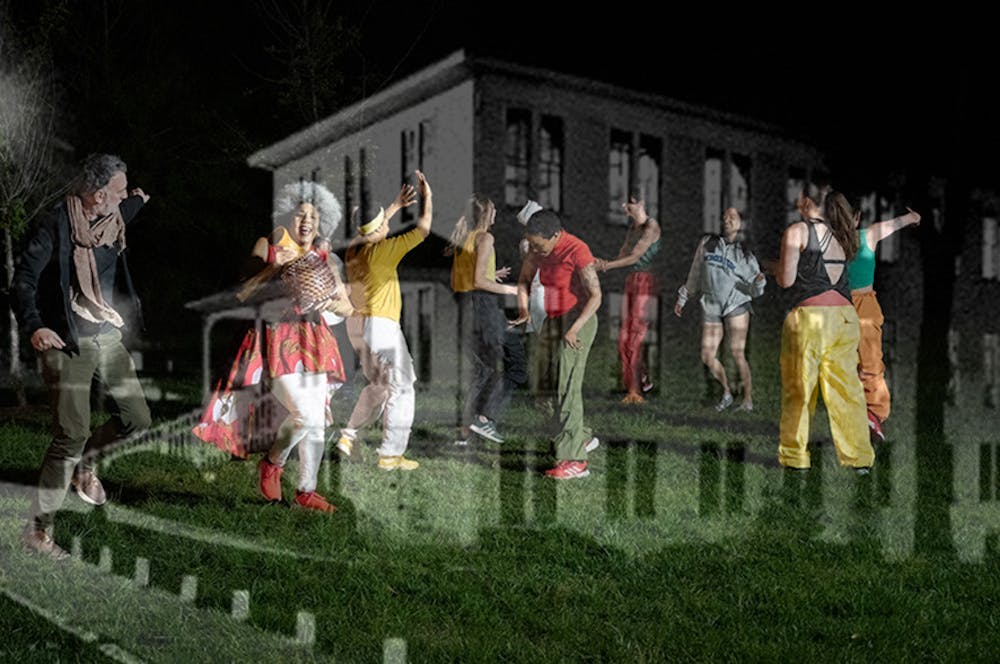At 7 p.m. on Oct. 3, walking behind Wilson Residence Hall, one could hear a live jazz band performing in the distance. This quiet corner of East Campus was brought to life, teeming with festivities while most students were settling down for the night. Candles lined the path to the statuesque, white wooden building known as “The Ark,” where the Duke Dance Program was holding their Centennial celebration.
Inside the building were numerous faculty and community members dancing on the black-and-white checkered linoleum floor. The full depth of the jazz music enveloped those who entered the building, making anyone who strolled in subconsciously sway from side to side. It was evident that the room was full of professional dancers. Those inhabiting the dance floor swung their arms and shook their hips, dancing like nobody was watching. The evening was a night of celebration.
The Ark is credited by the Duke Dance Program as the site of its 1982 origin. And while much of the Dance Program’s undergraduate curriculum is now held in the recently-constructed Rubenstein Arts Center (“the Ruby”), the Ark remains a hub for many of the program’s graduate students according to Dierdre Shipman, the Program Coordinator for the Dance Program. Shipman said that it is atypical for the organization to host a big event in the Ark, but tonight the whole program as well as the public were welcome to join the celebratory dance party.
Professor Andrea E. Woods Valdés, the Chair of the Dance Program and an Associate Professor of the Practice of Dance, was the true mastermind behind the night. When she tried to figure out how the program should celebrate Duke’s Centennial, the obvious answer for her was to host a dance party. Such a party would let the program share its passion for dance with the rest of the Duke community.
I certainly felt included by the program, as Valdés herself dragged me into the center of the dance floor so that I could bust some moves before we stepped outside to chat. Despite not being a dancer amongst a group of professionals, I found myself letting loose and having fun because of Valdés’ infectious energy and the spirit of the room. This moment embodied the purpose of the night.
In addition to celebrating the Dance Program, Valdés emphasized the importance of the night for drawing attention to the venue itself. The Ark, built in 1898, is one of the oldest buildings on campus, predating the renaming of Duke University. “We want to make sure that Duke recognizes it as a treasure, as a gem,” stated Valdés.
While now the Ark is home to the Dance Program, the building has served many purposes over the years. When it was built in 1898 with a donation from Benjamin N. Duke, the building was used as a gymnasium (making it likely the first college gym in the state) and was named after Angier B. Duke. Inside the gym were a bowling alley, running track, baseball batting cage and state-of-the-art gymnastic equipment. Foreshadowing Duke’s future basketball success, the Ark held one of the first intercollegiate basketball games in the state when on March 2, 1906, Trinity (Duke’s previous name) played Wake Forest. In 1923, the Ark became a cafeteria for men after the construction of a newer gym; then, in 1930, the Ark became the campus laundry room after the opening of a new cafeteria.
Once West Campus opened, making East Campus into a women’s campus, the Social Standards Committee of the Woman's Student Government and different classes renovated the Ark to be a student gathering space. In the 1930s, popular student bands would perform in the Ark every Saturday night. The Ark remained a hangout spot for social dance and relaxation until it was inhabited by the Duke Dance Program in 1982.
While Duke’s Centennial has given us the opportunity to reflect on how far we’ve progressed in 100 years, it is vital to not focus solely on Duke’s more modern and glamorous developments. While the construction of the Ruby is a grand example of Duke’s evolution, historical buildings like the Ark that have represented Duke through every era are important to recognize. The Centennial is about remembering the past and the people that got us here, not just looking toward the future. We can thank the Duke Dance Program for reminding us of that lesson.
Get The Chronicle straight to your inbox
Signup for our weekly newsletter. Cancel at any time.

